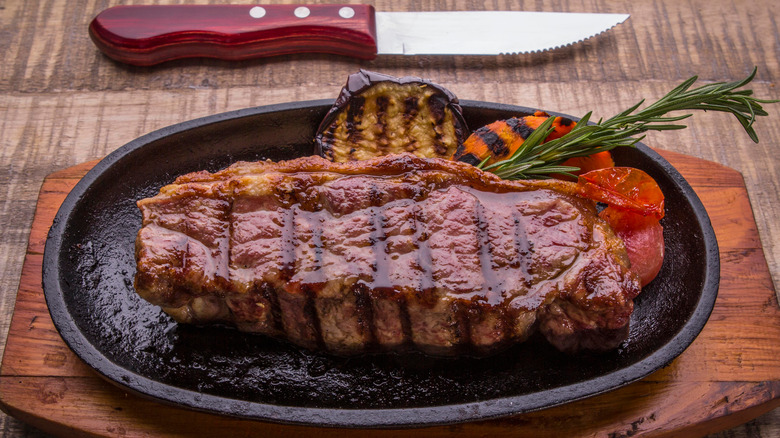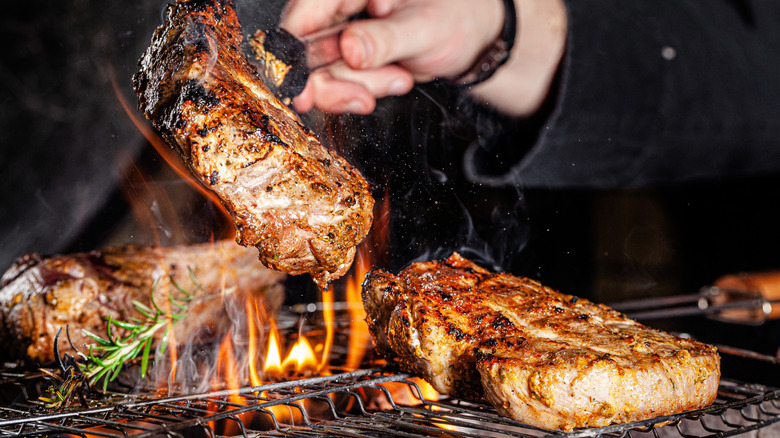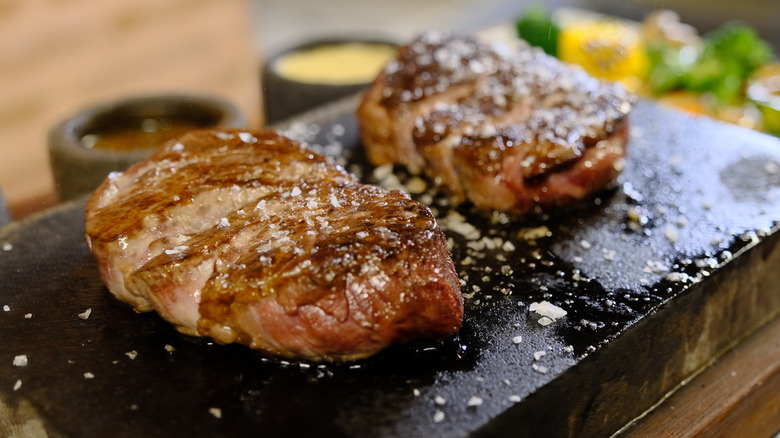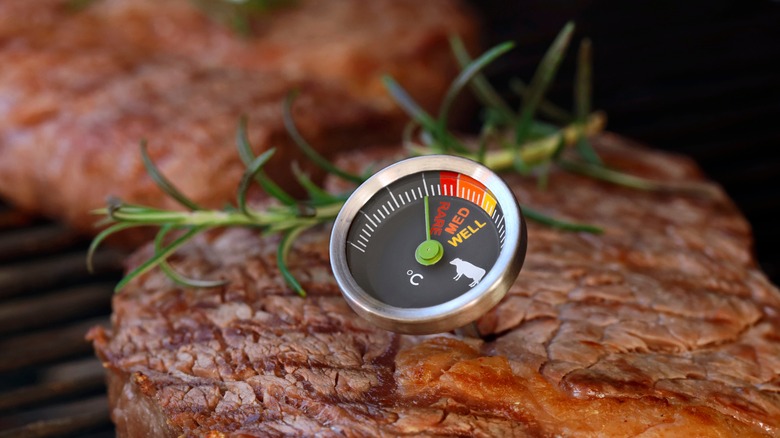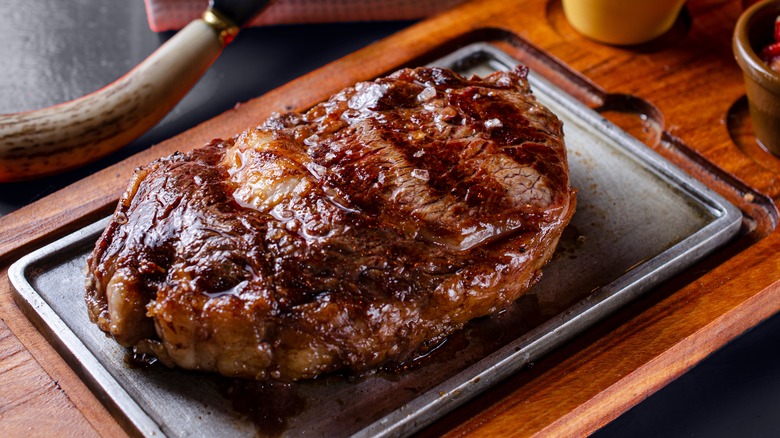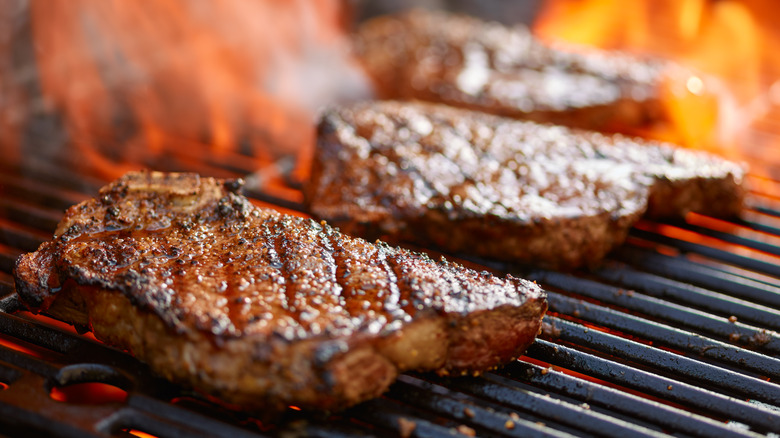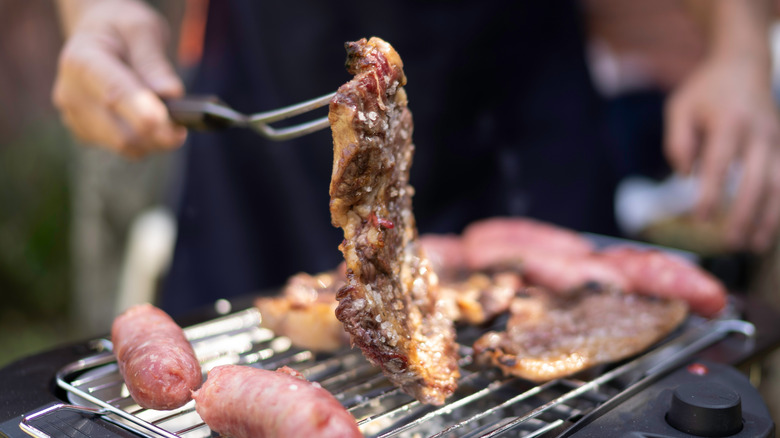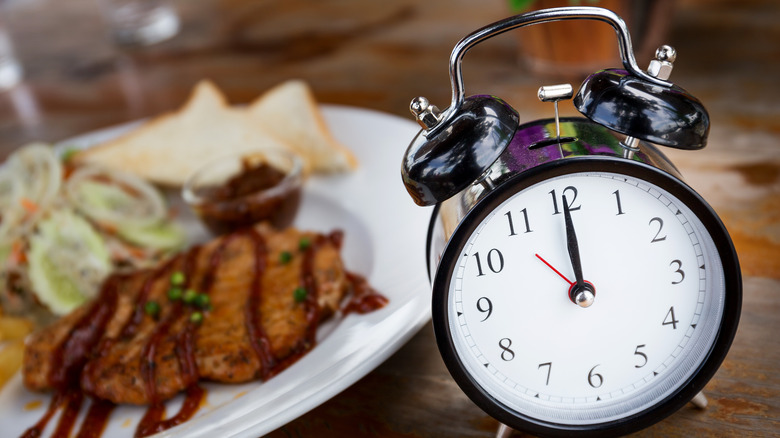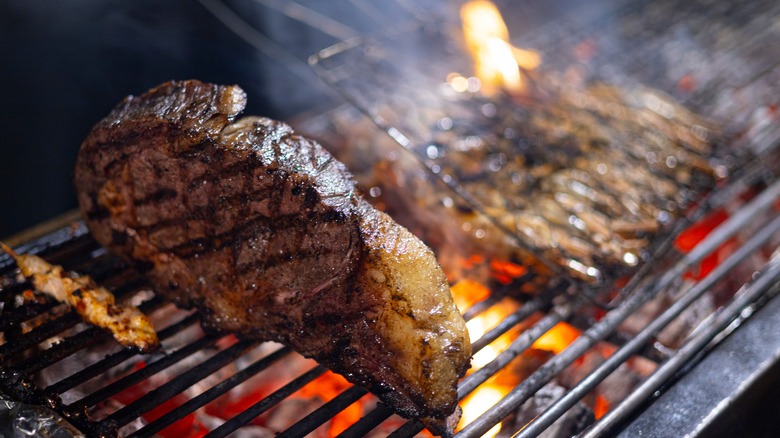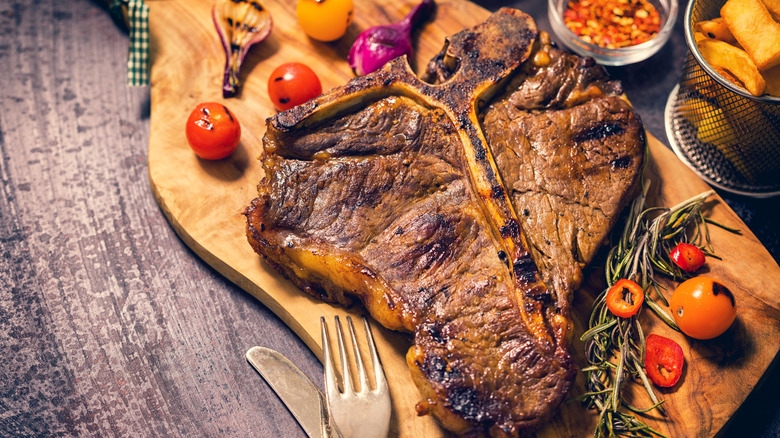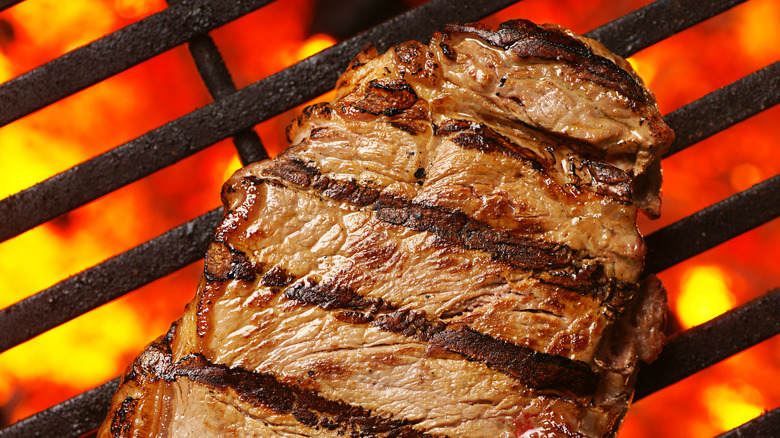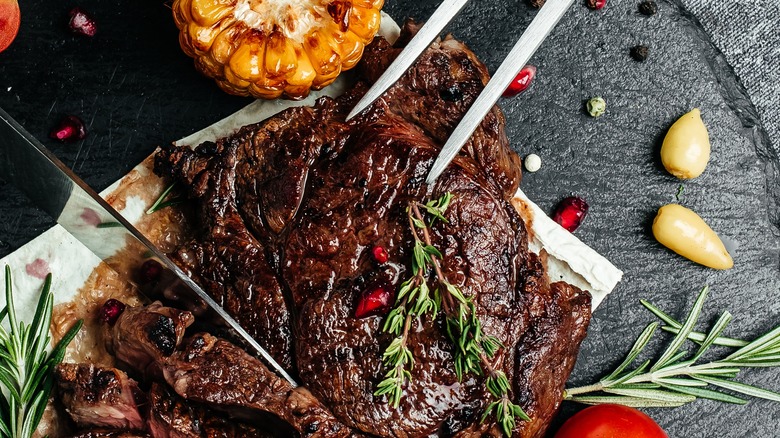11 Hacks To Tell When Your Steak Is Perfectly Cooked
When it comes to the most decadent and delicious foods you can pile on a plate, few things compare to a perfectly cooked steak. Regardless of whether you prefer a T-bone, New York strip, ribeye, or filet mignon, a well-cooked steak is juicy, tender, and succulent like nothing else. The beef is savory, packed with hints of umami goodness — and if you're lucky — surrounded with beautifully charred, perfectly rendered bits of fat that explode with flavor when you eat them. No wonder steak truly is the king of proteins.
This also explains why a poorly cooked steak can be such a disappointment. They can be tough and chewy. Or even so hard you can barely cut into them with a knife. Or, on the flip side, a steak might be so rare and undercooked that it's inedible for a whole slew of other reasons.
Much like pasta (or your favorite eggs, for that matter) or even a good soufflé, steak is one of those foods that's really at its best when it's cooked right. Not too well done, not too rare, but just right — cooked to the doneness you like best. In other words, made perfectly, just for you (or whoever you might be serving).
Keep reading for some hacks on how to cook the steak of your culinary dreams, every time you step into the kitchen — because cooking steak to perfection might be easier than you think.
Try the hand test
One of the easiest ways to measure the doneness of any steak — and something that can be tried at any time, without special tools — is what many chefs call the "finger," "hand," or "touch" test. In essence, you are simply comparing the feel of the steak as it cooks to the feel of different parts of your hand. While no one really knows where the test originated, it's based on centuries of cooking know-how in which chefs have found that as a steak cooks, it starts to take on the feel of different parts of the human hand. Here's how it works:
Open your hand and relax it. Now, touch the fleshy area between your thumb and the base of the palm. If you want to cook a steak until rare, you'll know it's done when it starts to feel similarly soft.
Prefer your steaks more on the medium rare side? No problem — touch your thumb to your index finger, and feel the same area once again. When a steak has reached medium-rare doneness, it should have a slightly firmer texture, similar to this touch.
For a medium steak, touch your thumb to your middle finger and feel this same fleshy area once again — it should feel even more firm. For medium well, touch your thumb to your ring finger. And finally, for a well done steak, touch your thumb to your pinky finger — the region should feel surprisingly firm. Easy, right?
Or touch your face and then feel the steak
Having trouble determining the firmness of different parts of your hands or looking for a way to doublecheck your work? Then you might want to try the "face test." It works in exactly the same way as the hand test does, except in this case you're comparing the doneness of your steak to different parts of your face instead of your hands.
In the face test, the firmness of the middle of your check is most comparable to the firmness of a rare steak. Moving to the center of your face, the tip of your nose represents the firmness you should feel when a steak is cooked to medium rare. The center of your chin represents the firmness you should feel when a steak is cooked perfectly to a nice medium doneness. And your forehead when it is relaxed will feel the way a well-done steak should feel as it just crosses over to that final level of cooked perfection.
For this test, you'll likely get the best results by touching parts of your face with one hand while touching your steak with the other, so you can immediately compare and contrast firmness and density. And of course, there are some limitations to this technique as well, especially if you have a beard or facial hair. In either case, the hand test may yield better results.
Grab a meat thermometer
If you're looking for something a bit more concrete to perfectly evaluate the doneness of your steak — something that doesn't rely on touch or feel — then you can't go wrong with a simple meat thermometer which can help you ensure your steak is always cooked to perfection.
To use a meat thermometer on your steak, first insert the probe of the thermometer horizontally into the thickest part of the steak. Aim for the center of the meat and avoid touching any fat or bone — both can give inaccurate readings. Let the thermometer stabilize for a few seconds and determine the correct reading. Once it is set, it's ready for review.
In general, if the temperature of the steak is 120 to 125 degrees F, the steak can be considered rare. A medium rare steak will be a bit warmer, 130 to 135 degrees F.
For a medium steak, look for temperatures between 140 to 145 degrees F. Medium well clocks in at 150 to 155 degrees F. And for a well done steak, the temperature should be 160 degrees F or above.
While there are a number of different meat thermometers on the market — everything from discount models that cost just a few bucks to high end options that can be read and controlled via Bluetooth on your phone — this model is a favorite for everyone from The New York Times and The Food Network to Alton Brown and Serious Eats.
Check the color of your steak and its juices
While a meat thermometer might be the most scientific way to keep tabs on a steak as it cooks, many chefs and home cooks swear by a more visual method of monitoring a steak's level of doneness — they watch the color of the steak's juices as the meat cooks.
A steak will release juice for a variety of reasons. Water trapped within the meat steams and evaporates, and some of that liquid also trickles out of the meat in the form of a savory juice. Connective tissues and fat within the meat also break down when exposed to heat. This process makes the meat more tender and tasty, and also contributes to the formation of juices.
As all of these processes are going on, the color of the juices being released as the meat cooks can yield valuable clues into just how far along the meat is in the cooking process, and when it will reach your ideal doneness.
When a steak is rare, its juices tend to be a deep red color. When a steak has reached medium rare, the juices will turn slightly more pink or clear. When a steak is cooked to medium, its juices will turn a light pinkish-brown.
In the medium-well stage, the juices of the steak become clearer and may have a slight brown tint. And for a well-done steak, the juices should be completely clear with no visible traces of pink or red.
Listen to the way the steak sizzles
Just as the color of the juices a steak releases while it cooks can clue you in on its level of doneness, so too can the noises your steak makes while cooking on the grill or in your cast-iron pan. Think of this process in monitoring the doneness of your steak as it cooks as the "sizzle" test.
As a steak first starts to warm up and cook and nears the rare stage of doneness, it typically creates a rather loud and vigorous sizzle. This is a result of the rapid change in temperature taking place within the meat as the center of the steak warms and moisture rapidly evaporates, creating that signature "hiss" as juices from the meat hit the warm metal the steak is cooking on.
When your steak reaches medium-rare, it will continue to sizzle, but the sound will also begin to quiet and will sometimes take on a more rhythmic quality which indicates that the outer layers of the meat are cooking and the center is continuing to warm.
At a medium and medium-well level of doneness, you'll find the sizzle becomes even slower and more subdued, fading further away as the meat cooks. And by the time that steak reaches well-done, it's sizzle will often have completely disappeared since most of the excess moisture in the steak has evaporated at this point and the center and exterior of the steak are both literally "well-done."
Jiggle the steak
At this point, you're likely starting to see some of the similarities that occur during the cooking process as a steak transitions from rare to medium to well-done. The exterior and center of the meat warm and cook (which we can measure with a thermometer), juices escape, and the color of those juices — as well as the sounds they make hitting the pan — all yield valuable clues into just how far along in the cooking process your steak is.
Well, another way that you can track this progress is by "jiggling" or poking your steak as it cooks — two more ways to observe just how much the meat has firmed as a result of being exposed to high heat.
When it comes to a steak that is either rare or medium-rare, your meat will feel soft and quite jiggly when lightly pressed or shook. It will feel "loose" and still provide a significant amount of movement if you lift it in the air.
A medium steak will feel firmer but will also still provide a slight give when pressed. That give will start to go away when the steak reaches medium-well. And if you jiggle the steak or lift it in the air, it will give minimal movement and will not be overly flexible.
And when a steak has reached well-done, it won't jiggle or give at all. The meat will still be tender to eat but won't provide significant movement when lifted or poked.
Set a kitchen timer
While all the strategies we've outlined already are highly effective in determining the doneness of a steak — and helping you to keep tabs on when it is cooked to perfection — they do require a bit of a judgement call here and there. Just how pink is that juice? Just how much of a sizzle do you actually hear?
If you're looking for options to monitor the doneness of your steak that aren't quite so subjective — like the temperature reading you get from a meat thermometer — then monitoring cooking time is another great option to consider. Of course, it's important to remember that your cut of steak, the thickness of the steak, and the initial temperature of the meat when you start cooking it will also all impact overall cooking time.
That said, there are some excellent guidelines to follow that will help you further perfect your cooking process. In general, a rare steak should be seared for one to two minutes per side and then finished in the oven or over indirect heat. For a medium rare steak, aim for two to three minutes per side. A medium steak needs a bit longer so it should get three to four minutes per side, plus that finishing time over more indirect heat.
For a medium-well steak, sear each side for four to five minutes. And for a well-done steak, you can go five minutes or longer, or until you get that ideal crust.
Look at the way the fat is rendered
One of the most wonderful things about steaks is that each cut is so different. Some have very little fat, and some (like the ribeye, porterhouse, and T-bone) have a beautiful edge of marbling that adds flavor and juiciness — and that can also be one more great way to determine when any steak is cooked to its ideal level of doneness.
While many people love the taste of a rare-cooked steak, beef that is only cooked to a rare temperature doesn't get as much flavor from fat. The marbling on a rare steak will soften and render some, but that fat will also remain relatively solid and firm. As a steak progresses to a medium level of doneness, its fat will become more translucent and you may begin to notice a more fatty glean on the meat from that fat cooking and liquifying.
When a steak reaches the medium well or well-done stages of doneness, its fat will have rendered the most. The edges of that strip of marbling may be crispy or caramelized and the fat itself will have reached its most translucent stage. As a bonus for those who love a well-done steak, this is also when that fat is at its most delicious!
Check the color of the bone
Similar to the way fat renders on your steak, the bone within a steak can also provide valuable clues to help you know when that protein is perfectly cooked. Of course, not all steaks are bone-in. But with those that are — T-bone, Tomahawk, porterhouse, and Cowboy steak come to mind — can provide essential clues to their doneness if you simply keep an eye on those bones as the meat cooks. (Note that while the color of the bone itself won't really change, it's the meat around the bone that yields the most valuable hints as to overall doneness.)
For a rare steak, the meat around the bone will likely remain fairly red. As the meat progresses to medium rare, it will turn more of a pink color in the area immediately surrounding the bone.
At a medium level of doneness, the meat touching the bone within the steak will typically have turned a very light pink or even a light tan color. At medium well, this color will be a more uniform light brown. And when a steak is well-done, the meat surrounding the bone will be either be darker brown or even a light gray without any visible signs of pinkness.
(And in case you're curious, the choice to go bone-in or boneless should be purely based on personal preference. Despite much debate, there is no actual difference in flavor based on whether a steak has a bone or doesn't.)
Keep tabs on the steak's sear marks
Cooking your steak on a grill or in your favorite grill pan? If so, then those beautiful char or sear marks left by the grill grate can be one more powerful tool in tracking just how well your steak is cooked, and what level of doneness it has reached.
A rare steak will typically have seared quickly and will have very well-defined grill marks. The marks will be highly browned and possibly slightly charred on the surface. At the same time, the interior of the steak will remain cool to the touch, and there will be a vibrant, reddish-pink color at its center.
A medium-rare steak will still have distinct grill marks, but they may be slightly less pronounced than on a rare steak. The surface will be well-seared with a mix of brown and charred areas.
For a medium steak, the grill marks will be even less visible as the sear becomes more uniform to the overall color of the cooked meat. In this case, the surface will have a more consistent and overall brown color. In the medium-well stage, your steak's grill marks may be nearly obscured as the surface of the beef has become even more uniformly browned.
And for a well-done steak, those grill marks might seem almost invisible. Your steak should instead look thoroughly browned and have an overall uniform surface color without any prominent lines.
If all else fails, make a small cut in the steak
It's never a good idea to cut into a partially cooked steak — you risk the loss of wonderful flavor and juices. But even though it's a no-no, sometimes there's no better way to know whether your steak is actually cooked to your liking or not, so it has to be done.
Fortunately, there are some ways to minimize the damage from making that cut. For starters, keep the cut as small as possible. Cut closer to the center of the steak than the edges so you can get the truest possible picture of just how done your steak is, and make your cut in the least conspicuous spot possible so your presentation of the meat isn't ruined (if you're serving to others).
Also, always use the sharpest knife possible so you make a clean cut. A dull knife can tear the meat, leading to the loss of even more juices. Once you've made your cut, be sure you know what to look for. If you want your steak rare, the meat inside the cut should be bright red and cool to the touch. For a medium rare or medium steak, the meat inside the cut should be reddish-pink with just the slightest hint of red in the center.
For medium well, the meat should be nearly cooked through — and for well-done it should be the same color on the inside as it is on the outside.

